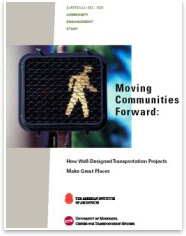
| AIA Study Identifies Keys to Well-Designed Transportation Projects Federal study released to Congress
"The findings show that small decisions have major effects on how a transportation project impacts its community,” says David T. Downey, Assoc. AIA, managing director of the AIA Center for Communities by Design and co-director of the study. “In particular, it was striking to see how involving the public in a design process that incorporates all applicable disciplines—architects, engineers, planners, landscape architects, contractors, and government officials—can achieve a solution that has multiple benefits for a community." Six key design strategies
According to Andrew Goldberg, Assoc. AIA, senior director of Federal Affairs and the other study co-director, these results will help shape the next highway bill. "The 2005 law expires in 2009, and key congressional committees are beginning to look at how to use the next bill to improve transportation policy,” Goldberg says. “The study's findings, particularly the importance of an integrated design process and the emphasis on sustainability, will no doubt help policymakers recognize the central role that architects play in ensuring that transportation projects create livable and sustainable communities." |
||
Copyright 2008 The American Institute of Architects. All rights reserved. Home Page |
||
news headlines
practice
business
design
Read the Moving Communities Forward report.
For more information on the study, contact the AIA Government Advocacy team at govaffs@aia.org or 202-626-7307 for politically related questions, or e-mail the Center for Communities by Design for substantive ones..

 Summary:
Summary: Advocacy effort
Advocacy effort